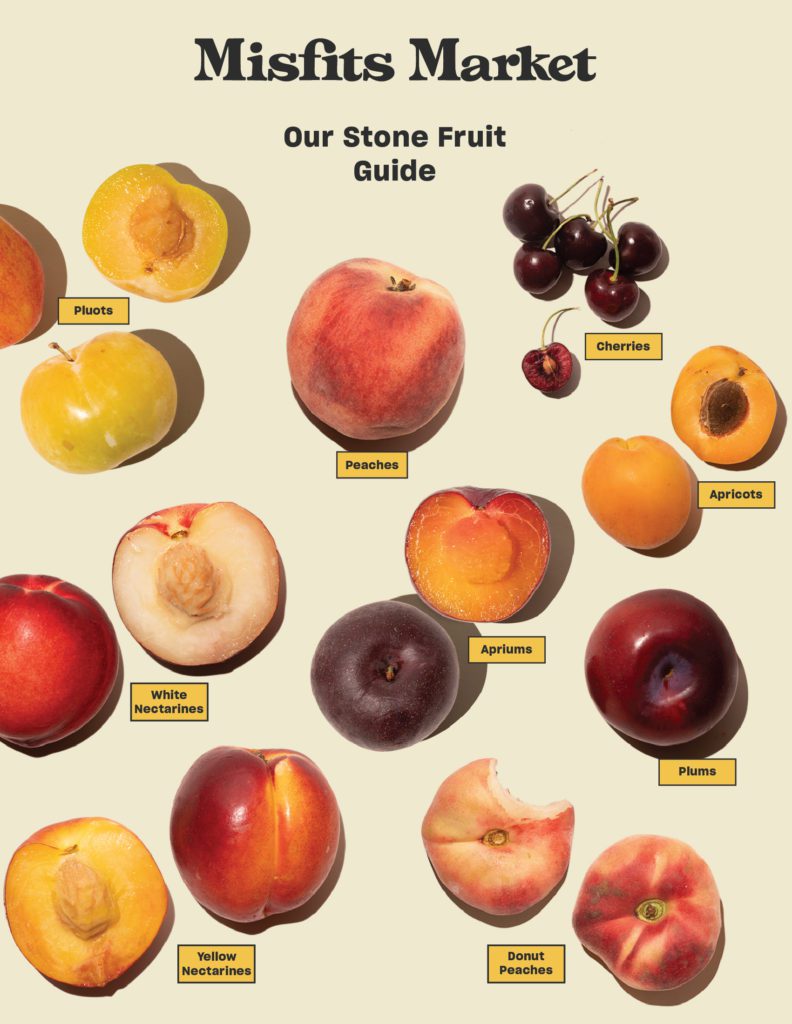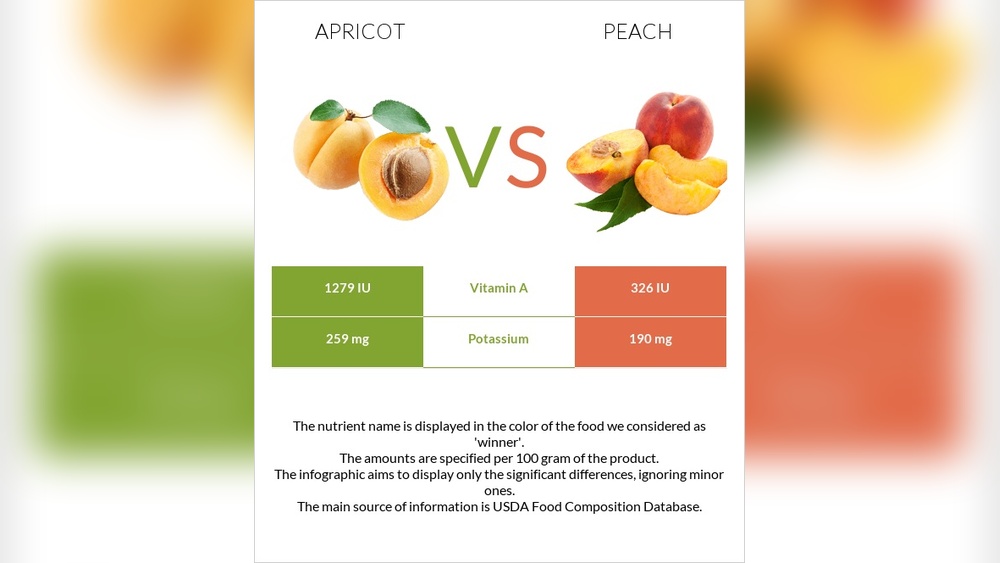As an Amazon Associate, I earn from qualifying purchases.
When you pick up a peach or an apricot at the market, you might wonder: are these fruits really that different? They look similar, but the truth is, each has its own unique taste, texture, and size that can change your eating experience.
If you’ve ever been confused about which one to choose or how to use them in your recipes, you’re not alone. Understanding the key differences between peaches and apricots will help you enjoy their flavors to the fullest and make better choices for your meals.
Keep reading, and you’ll discover what sets these two fruits apart—and which one might be perfect for your next snack or dish.
:max_bytes(150000):strip_icc()/peach-nectarine-apricotArtboard-1-copy-5-6d5e9fcceed1497db3192338c9db9ef6.jpg)
Appearance And Size
The appearance and size of peaches and apricots show clear differences. These fruits share some traits but have distinct looks. Understanding these differences can help you identify them easily.
Skin Texture And Color
Peach skin has a soft, fuzzy texture. It feels like a gentle peach fuzz on your fingers. Apricot skin is smoother and less fuzzy. It has a slight velvety feel but is mostly smooth.
Color-wise, peaches often have a mix of yellow, orange, and red. The red blush can cover a large part of the fruit. Apricots are usually a solid orange or yellow-orange. They rarely show red hues.
Fruit Dimensions
Peaches are larger than apricots. A typical peach is about four times bigger than an apricot. Peaches can reach the size of a small fist.
Apricots are smaller and rounder, about the size of a golf ball. Their compact size makes them easy to snack on. This size difference is one of the easiest ways to tell them apart.
Taste Profile
The taste profile of peaches and apricots highlights their unique qualities. Both fruits belong to the same family but differ in flavor and texture. Understanding these differences helps in choosing the right fruit for snacks or recipes.
Sweetness Levels
Peaches are generally sweeter than apricots. Their sugar content is higher, which gives peaches a rich, sugary taste. Apricots have a balanced sweetness with a slight tartness. This tartness adds a refreshing zing to apricots. The difference in sweetness makes peaches perfect for desserts. Apricots work well in dishes that need a subtle sweet and sour touch.
Juiciness Comparison
Peaches are very juicy fruits. They release a lot of liquid when bitten into. This juiciness makes them refreshing and hydrating. Apricots are less juicy but still moist. Their flesh is firmer and denser. This makes apricots ideal for baking and drying. The juiciness level affects the eating experience of each fruit significantly.
Flavor Notes
Peaches have a bold and fragrant flavor. They often carry floral and honey-like notes. Apricots offer a milder, more delicate flavor. Their taste includes hints of citrus and almond. Apricots’ flavor is more complex with a mix of sweet and tart. Both fruits provide unique tastes that suit different culinary uses.
Nutritional Value
The nutritional value of peaches and apricots offers important insights into their health benefits. Both fruits belong to the same family but differ in nutrient content. These differences affect how they contribute to a balanced diet. Understanding their vitamins, minerals, calories, and health benefits helps make better food choices.
Vitamins And Minerals
Peaches provide a good amount of vitamin C and vitamin A. They also contain potassium and small amounts of magnesium. Apricots are rich in vitamin A, especially as beta-carotene. They have higher potassium than peaches. Both fruits offer antioxidants that protect cells from damage.
Caloric Content
Peaches have slightly more calories due to higher natural sugars. A medium peach contains about 58 calories. Apricots are lower in calories, with about 48 per fruit. Both are low-calorie snacks, suitable for weight management. Their natural sugars provide quick energy without excess calories.
Health Benefits
Eating peaches supports skin health and boosts immunity. Their vitamin C helps heal wounds and fight infections. Apricots aid eye health thanks to their high vitamin A. Both fruits improve digestion with their fiber content. They also help reduce inflammation and promote heart health.
Growing Conditions
Growing peaches and apricots requires understanding their specific needs. Both fruits thrive in temperate zones. Yet, their climate preferences and harvest seasons differ. Knowing these details helps gardeners and farmers achieve better yields and quality.
Proper growing conditions impact fruit size, taste, and texture. Soil type, water availability, and sun exposure also matter. Each fruit has unique demands for optimal growth and fruiting.
Climate Preferences
Peach trees prefer warmer climates with long, hot summers. They need chilling hours during winter, but not extreme cold. Ideal temperatures range from 65°F to 85°F (18°C to 29°C). Too much frost harms peach buds and flowers.
Apricot trees tolerate cooler climates better than peaches. They require fewer chilling hours but are sensitive to late spring frosts. Apricots grow well in areas with dry summers and cold winters. They need full sun for the best fruit quality.
Harvest Seasons
Peach harvest season varies by variety but usually falls between late June and August. Early varieties ripen in June, while late types can be ready by September. Peaches must be picked when fully ripe for sweet flavor and juiciness.
Apricots have a shorter harvest season, typically from May to July. They mature earlier than peaches. Harvest timing is crucial to avoid overripe or underripe fruit. Apricots are best harvested when firm but slightly soft to touch.
Culinary Uses
Peaches and apricots share many similarities but differ in culinary uses. Both fruits offer unique flavors that suit different dishes. Understanding these uses helps in choosing the right fruit for your recipe.
Peaches are juicy and sweet, ideal for fresh eating and desserts. Apricots have a firmer texture and tart flavor, perfect for cooking and preservation. Each fruit has its place in the kitchen depending on taste and texture preferences.
Fresh Consumption
Peaches are often eaten fresh due to their juicy sweetness. They make a great snack or salad ingredient. Apricots, being smaller and less juicy, are also enjoyed fresh. Their tangy flavor adds brightness to fruit bowls and platters.
Cooking And Baking
Peaches soften well when cooked, making them perfect for pies and cobblers. Their sweetness balances well with spices like cinnamon. Apricots hold their shape better in baking. They add a tart contrast in tarts, jams, and sauces.
Preservation Methods
Both fruits can be preserved by drying, freezing, or canning. Apricots are popular for drying, retaining their flavor and nutrients. Peaches freeze well for smoothies and desserts later. Canning preserves both fruits for year-round use.

Storage And Shelf Life
Proper storage greatly affects the freshness of peaches and apricots. Both fruits are delicate and can spoil quickly without care. Knowing how to store them extends their shelf life. It also keeps their taste and texture intact. This section explains the best ways to store each fruit. It also highlights how long they last under different conditions.
Optimal Storage Tips
Store peaches and apricots at room temperature if they are not ripe. Place them stem side down on a soft cloth or paper towel. Avoid stacking to prevent bruising. Once ripe, move them to the refrigerator to slow down ripening. Use a plastic bag with holes to keep moisture balanced. Do not wash fruits before storing. Wash only before eating or cooking. Keep peaches and apricots away from strong-smelling foods. They can absorb odors easily.
Shelf Life Differences
Peaches generally last longer than apricots when refrigerated. Ripe peaches can keep for 3 to 5 days in the fridge. Apricots are more delicate and usually last 2 to 3 days. At room temperature, both fruits ripen quickly within 1 to 2 days. Overripe peaches may become very soft but still edible. Apricots spoil faster and may develop mold if left too long. For the best taste, consume both fruits soon after they ripen.
Common Varieties
Peaches and apricots come in many varieties. Each type offers unique flavors and textures. Knowing common varieties helps in choosing the right fruit for your needs. Both fruits have popular cultivars enjoyed worldwide. They differ in size, taste, and juiciness. Understanding these varieties adds value to your fruit knowledge.
Popular Peach Types
There are three main peach types: clingstone, freestone, and semi-freestone. Clingstone peaches have flesh that clings to the pit. They are juicy and sweet. Freestone peaches have pits that separate easily from the flesh. They are great for eating fresh and baking. Semi-freestone peaches offer a mix of both traits. Varieties like Elberta and Red Haven are well-known freestone peaches. Donut peaches have a flat shape and a mild taste. Each type has its own uses in cooking and fresh eating.
Popular Apricot Types
Apricots are smaller and firmer than peaches. Popular types include Moorpark, Tilton, and Katy. Moorpark apricots are large and flavorful. Tilton apricots have a bright orange color and tart taste. Katy apricots are smaller and grow well in cooler climates. Apricots usually have a smooth, slightly fuzzy skin. These varieties work well for drying, jams, and fresh eating. Their sweet-tart flavor makes them distinct from peaches.
:max_bytes(150000):strip_icc()/GettyImages-72422696-2000-1ef638b57cc04d668a3eed0b62d86216.jpg)
Cultural Significance
Peaches and apricots hold a special place in many cultures around the world. Their cultural significance goes beyond taste and nutrition. Both fruits appear in art, literature, and traditions, symbolizing various ideas. Understanding their cultural roles reveals how deeply these fruits influence human history and society.
Symbolism In Different Cultures
Peaches often symbolize immortality and unity in Chinese culture. They represent longevity and good luck during festivals. Apricots, on the other hand, symbolize beauty and fertility in Middle Eastern traditions. In some cultures, apricots stand for hope and renewal. Both fruits appear in folklore and religious stories, highlighting their spiritual importance.
Traditional Uses
Peaches are used in many traditional ceremonies and celebrations. In Japan, peach blossoms are linked to spring festivals and protection against evil. Apricots have a history of use in medicinal remedies in Central Asia. They are also common in traditional dishes and preserves. Both fruits serve as symbols of harvest and prosperity in various communities.
Frequently Asked Questions
Are Apricot And Peach The Same?
No, apricots and peaches are different fruits. Peaches are larger, juicier, and sweeter. Apricots are smaller with a sweet-tart flavor. They belong to the same fruit family but differ in size, taste, and juiciness.
What Is Healthier, Peach Or Apricot?
Apricots are lower in calories and richer in fiber. Peaches provide more vitamin C and are juicier. Both offer unique health benefits.
What Do Mexicans Call Apricots?
Mexicans call apricots “albaricoques. ” This term is widely used in Mexico for the fruit.
Are Apricots And Peaches Cousins?
Apricots and peaches are related stone fruits from the same family. They differ in size, taste, and juiciness.
What Is The Main Difference Between A Peach And An Apricot?
Peaches are larger and juicier, while apricots are smaller with a sweet-tart flavor.
Conclusion
Peaches and apricots both offer unique tastes and textures. Peaches are larger and very juicy with a sweet flavor. Apricots are smaller, firmer, and have a tart-sweet taste. Both fruits belong to the same family but serve different uses in cooking and snacking.
Choosing between them depends on personal taste and recipe needs. Enjoy these delicious fruits fresh or in your favorite dishes. Each fruit brings a special touch to your meals and snacks.

